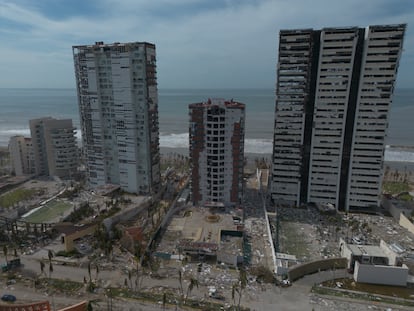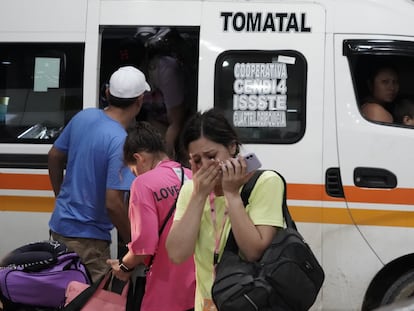The forgotten survivors of Hurricane Otis: ‘We don’t even have water to wash with, and now disease is setting in’
Residents of Pie de la Cuesta, Mexico, a working-class neighborhood that caters to tourists in neighboring Acapulco, are struggling to survive without water, electricity and barely any food, one week after disaster hit

When Andrés awoke, there was a fresh grave in the cemetery. Though calling it a grave would be generous: it was a body, wrapped in a sheet, no coffin or headstone, buried quietly in a shallow hole during the early hours of the morning. Lacking everything, the dead body didn’t even have a name. The neighbors had to tie up their dogs: the body was buried so shallow that the animals, attracted by the smell, would try to dig up the corpse. The place the person was laid to rest in is not really a cemetery either — just a few holes, dug into the side of a hill that can’t be reached by car, only by a narrow dirt path that traverses the shadow of Acapulco’s decadent and glamourous facade: the community of San Isidro, in the resort town of Pie de la Cuesta, a neighborhood inhabited by the workers who clean, maintain, and serve the patrons at the nearby resorts and hotels; the people who cook in the restaurants and take tourists out on boats; the workers who survive on the margins of a city that someone who never stepped foot in San Isidro dubbed La perla del Pacífico — The Pearl of the Pacific.
Overpopulated and built on a mountain by the people who live in it, the settlement has always been a catastrophe waiting to happen: a magnet for landslides, earthquakes and hurricanes, like Otis, which just a week ago flattened the houses, stripped the palm trees, and killed the person now buried next to Andrés’ home. Amid all the destruction, someone had at least thought to put fresh-cut flowers on that sad mound of earth.
“We don’t know if they were a woman or a man, we didn’t get a chance to see. I think they came to bury them at night, when we were all sleeping.”
The old man slouches over the grave. There’s a cross made from two pieces of wood tied together, and a candle still burns inside a rusty tin can that protects it from the wind. Andrés estimates about five bodies have been added to the graveyard since the hurricane tore apart the sky and dislodged the earth in the early morning on Wednesday, October 25. Or maybe more like 10: at this point, who’s counting?. In any case, none of these victims are included in the official casualty figures presented by the government — 46 dead and 59 missing — which have yet to take into account San Isidro. Andrés’ house, which has been stripped to its skeleton, is not included in official statistics either, which report the destruction of some 7,000 hectares of buildings equating to roughly $15 billion in economic damage — plus whatever San Isidro and all the other communities no one has bothered to ask about would add to the figures.
Hurricane Otis slammed into Mexico’s Pacific Coast as a category 5 — the highest on the Saffir-Simpson scale. Ramón Loya (27), who has lived in San Isidro for two decades, endured the onslaught in the wood and sheet-metal shack he built years ago to provide a roof for his wife, Itzel (21), and their son, Fernando (4). First came a deceptively gentle wind. Then the rain. “The sheets started to blow off the roof, so I grabbed my wife and son and we went to find another shelter.” Loya’s home is, or was, attached to his aunt’s house, which is made of cement, and they sought refuge inside: everyone crouching on the ground, mattresses placed against the windows.
“It was like a tornado, the wind ricocheting off the hill and pulsating like there was a helicopter right outside.”
A few hours later, Loya’s home was a jumble of broken wood and iron. His aunt’s house didn’t fare well either: the structure withstood the storm, but the roof of the second floor was blown away by the hurricane. Nevertheless, the two rooms of the house that survived the destruction now shelter a dozen relatives who met the same fate as Loya. “My aunt feels horrible. Who doesn’t? All her life spent working and...” Instead of finishing the sentence, he just stares out at the rubble. “We’ve been abandoned,” he says. “We’re at the top of the hill, and it’s really hard for [the authorities] to get up here. No one has come to see us. Cars can’t get up here. Food and water are hard to come by. We’re getting desperate. Even if we’re some of the last ones, I hope they don’t forget [about us].” As Loya speaks, on the wall behind him, several freshly caught fish are drying in sun. This will be their next meal.
A tourist town with no tourists
Don Hector (70) still remembers when Pie de la Cuesta was a long strip of verdant land stretching out between the Pacific and a large lagoon of shimmering water, when there were no houses, restaurants or tourists. “Now there’s even a boulevard,” he says. He’s lived here for more than five decades and has never witnessed anything like Hurricane Otis. He makes a living, like Loya, taking tourists on boat rides. The hurricane destroyed his oceanfront home, leaving the walls “stripped to the bone.” Now the old man spends his days wandering around the lighthouse pier with nothing to do. He passes the time spotting all the boats wrecked and sunk by the storm. For a town that survives on tourism, few images reflect the situation better than Don Hector’s lost gaze.
Loya has a hard time getting his boat out to sea. The hurricane swamped it in a mess of water hyacinths, an invasive aquatic plant, that get tangled in the engine and clog it up. Little by little, he manages to make his way through a thick sea of green. “About 15 boats sank, but we’re already starting to pull them out,” he says. “We had a really nice 250-meter-long floating dock, but it was destroyed. The mangroves were really nice too, but they’re all gone now.” He steers the boat across the lagoon and recites the speech he normally gives to tourists: he talks about the different varieties of fish, the Isla de los Pájaros, or how Sylvester Stallone filmed Rambo II at the Pie de la Cuesta naval base. From the water, you get another perspective on the wreckage: the submerged boats, which a group of men are working to retrieve from the water, the pulverized palapas (simple, thatched-roof dwellings, usually open on the sides) on the shore, three fishermen with nets, trying to catch something to eat.
On a good day, Loya would earn $1,000 pesos (about $55 USD); on a bad one, $300 ($17 USD). December, high-season, the best month for business, is just around the corner, but after the hurricane, who will want to come visit? “Before, we would have been happy because high season would be coming and we’d have at least a little money saved up. But now, all of a sudden, [Otis] has taken it all away.”
“You could feel the floor moving, like it wanted to rip out from under you.”
Pie de la Cuesta has a main street, tourist lodgings, bars and restaurants, luxury residences for the wealthy — many of them foreigners — and another handful of houses where the towns other residents live: working people, the poor. When Otis hit the coast, its location, which on any other day would be considered a natural paradise, made it an especially vulnerable target.
Residents have already endured a week without electricity, water, internet or food. In the face of the destruction, many have given up and left to go stay with family or friends. The sides of the highway are piling up with rubble, garbage, and felled trees and telephone poles. Military and medical vehicles drive back and forth on the roads; stores are looted out of necessity; a long line forms of people waiting to receive food and basic necessities distributed out of the back of a truck; another to fill water jugs; another to receive relief funds from the Army, even though there’s nowhere to spend the money.
María de Jesús Abraham Rivera (46) walks among the ruins of what used to be her restaurant. Located on the beach, the business took the full force of Otis’s impact with nothing to cushion it. “Here’s where the enramada (a structure similar to the palapas mentioned earlier) used to be. Here there was a pool for the kids, because the beach is all open ocean and it’s really dangerous.” Now all that’s left is a tangle of wood, broken chairs and tables, some palm leaves that once served as a roof, and some sand and coconuts. “They say the material damage can be repaired. But that’s only true for people with money. How will we rebuild? No, not us. This is all we have, what we’ve built ourselves over many years. My dad built the shack and did everything himself. Now that he’s no longer with us… labor is very expensive. The truth is, we’ve been forgotten. Even though we’re surrounded by houses of pure money,” Rivera says.
She still cries when she remembers the arrival of the hurricane. A few hours before it hit land, all they knew was that a tropical storm was on its way. School was cancelled and her children (9 and 10) were at home. “Around 7 o’clock they started saying it had risen to a category 1, category 2 hurricane,” she remembers. “At 8 o’clock the buses stop running, what were we going to do?” At 11 p.m. they went to bed. And at midnight, a 250 kilometer-per-hour gust of wind shook at their door with a fury these shores had never seen.
“We had never, ever seen anything like this before,” Rivera says. “We had experienced big earthquakes and tidal waves, but never winds like this. It was like a tornado that came from over there,” she says, pointing to the right, “and then from over here,” she adds, pointing to the left. “It roared like thunder every time a gust of wind would hit. It roared like when there’s an earthquake. You could feel the floor moving, like it wanted to rip out from under you. We were sitting down and we felt like it was going to lift us up. All the glass windows were shattered, all the roofs of the houses…”
They spent the two hours it took the hurricane to pass them over lying on the floor, cornered against a wall, scared to death thinking they would be blown away at any moment. Since they live in a second-floor home attached to the back of the restaurant, they crowded into their sister’s house for safety. Of their home, only the framing remains. For the past week, they have survived by burning the debris Otis left to cook the fish they had hoped to sell to their customers, but are now eating themselves — though they also distributed a lot of it to their neighbors, so it wouldn’t rot and go to waste. “It’s bad, it really is. We don’t even have water to wash ourselves, and now disease is setting in. My son got hemorrhagic dengue. Here, we’ve been totally forgotten, there aren’t even any doctors.”
“Otis left us with nothing”
Government representatives showed up this Wednesday on the main street of Pie de la Cuesta. A week after the hurricane, they toured the houses to assess the damage. They have just passed by the house of Leova Reséndiz (82) and her mother-in-law Gudelia Torres (88), who despite their age take care of a younger relative who suffers constant epileptic seizures and spends his days resting in a hammock. Otis has taken what little they had: except for the four cement walls, everything else was blown away. They managed to survive only because one of their sons helped them evacuate before the hurricane hit. “Thank God we got out,” Reséndiz says. “Otherwise what would have become of us?”.
The house smells of stagnant water and rotting garbage; the women don’t have the strength to clean up. Even so, the authorities told them that they will not be able to receive any compensation from the state, because their legal documents disappeared with the wind, as also happened to many of their neighbors. “We are very poor. This week has been really bad, there’s no water, no electricity, there’s nothing in the stores. Some people have brought us a few things to eat, because [Otis] left us with nothing,” Reséndiz laments. Then she shrugs her shoulders and lets out “ni modo” — “oh well” — with the resignation of someone who has spent a whole lifetime accustomed to losing.
Sign up for our weekly newsletter to get more English-language news coverage from EL PAÍS USA Edition
Tu suscripción se está usando en otro dispositivo
¿Quieres añadir otro usuario a tu suscripción?
Si continúas leyendo en este dispositivo, no se podrá leer en el otro.
FlechaTu suscripción se está usando en otro dispositivo y solo puedes acceder a EL PAÍS desde un dispositivo a la vez.
Si quieres compartir tu cuenta, cambia tu suscripción a la modalidad Premium, así podrás añadir otro usuario. Cada uno accederá con su propia cuenta de email, lo que os permitirá personalizar vuestra experiencia en EL PAÍS.
¿Tienes una suscripción de empresa? Accede aquí para contratar más cuentas.
En el caso de no saber quién está usando tu cuenta, te recomendamos cambiar tu contraseña aquí.
Si decides continuar compartiendo tu cuenta, este mensaje se mostrará en tu dispositivo y en el de la otra persona que está usando tu cuenta de forma indefinida, afectando a tu experiencia de lectura. Puedes consultar aquí los términos y condiciones de la suscripción digital.
More information
Archived In
Últimas noticias
Petro claims the ELN was the target of US attack in Venezuela
Maduro counterattacks Trump with rhetoric and announces downing of nine drug trafficking aircraft
‘Ecce Homo’: The miraculous disaster that made a small Spanish town famous
Return to sex testing at the Olympics: IOC edges closer to banning transgender women
Most viewed
- Sinaloa Cartel war is taking its toll on Los Chapitos
- Oona Chaplin: ‘I told James Cameron that I was living in a treehouse and starting a permaculture project with a friend’
- Reinhard Genzel, Nobel laureate in physics: ‘One-minute videos will never give you the truth’
- Why the price of coffee has skyrocketed: from Brazilian plantations to specialty coffee houses
- Silver prices are going crazy: This is what’s fueling the rally










































